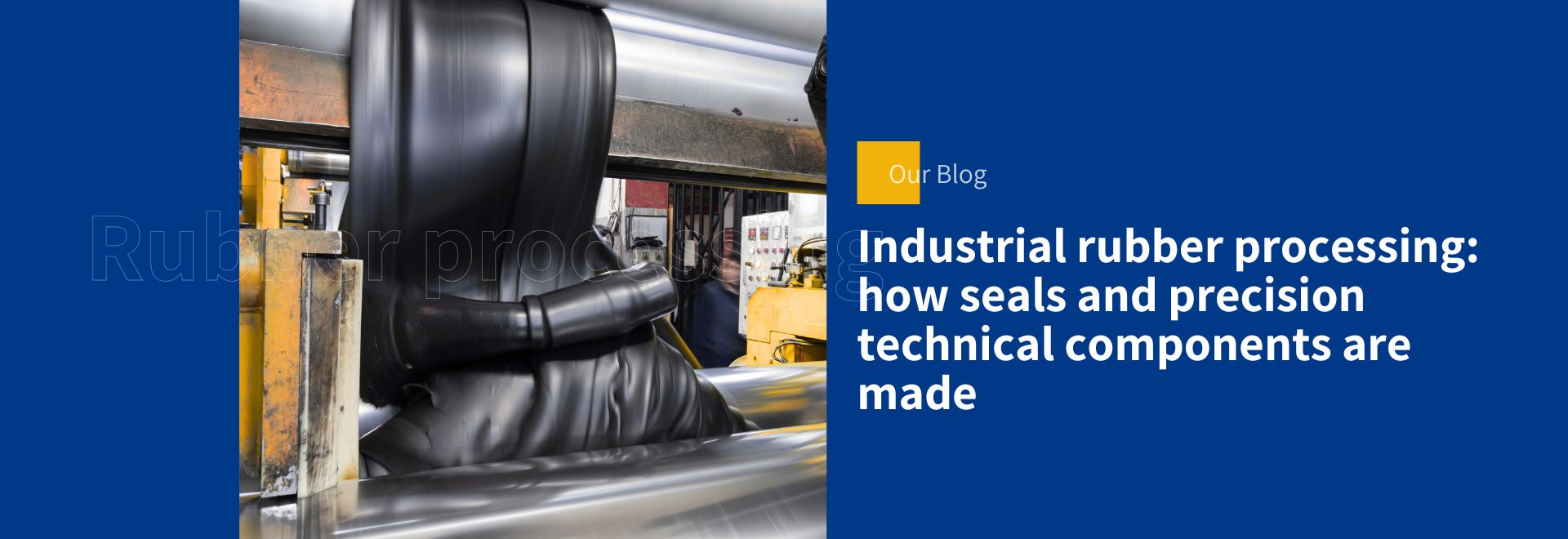
Solid, flexible, durable, and incredibly versatile—rubber is one of the most widely used and strategically important materials in industrial manufacturing. From high-tech sectors such as automotive, aerospace, and medical to more everyday applications, rubber processing plays a key role in the production of high-performance components.
But how is a raw elastomer transformed into a highly engineered finished product? The answer lies in a complex production cycle involving precise stages such as mixing, calendering, extrusion, molding, vulcanization, and finishing. Each step requires technical know-how, strict quality control, and—most importantly—cutting-edge machinery capable of ensuring quality, reliability, and repeatability on an industrial scale.
In this guide, we’ll walk you through every phase of rubber processing, explaining each step in a clear yet technical way, and highlighting the mechanical solutions and professional equipment involved. A resource designed for engineers, designers, and industry professionals, but also useful for anyone curious about how one of the most important materials of our time is truly processed.
Index
- What is rubber processing?
- What are the stages of rubber processing?
- Rubber processing: why choose Casati Macchine?
What is rubber processing?
Rubber processing is a structured industrial process that transforms raw materials—whether natural or synthetic—into finished or semi-finished products used across a wide range of industries.
Through techniques such as mixing, extrusion, molding, and vulcanization, rubber acquires specific mechanical and chemical characteristics, making it an extremely versatile material.
Natural rubber, extracted from the latex of the Hevea brasiliensis tree, offers excellent elasticity. Synthetic rubbers—such as SBR, EPDM, NBR, or silicone—deliver high performance in specific conditions like exposure to oils, high temperatures, or atmospheric agents.
The importance of rubber in modern industry is undeniable: it is used in automotive, construction, electronics, medical, and aerospace sectors thanks to its strength, flexibility, and insulating capabilities.
What are the stages of rubber processing?
The industrial rubber processing workflow involves several consecutive phases, each crucial to ensuring the quality, performance, and durability of the final product. Below we analyze the key steps—from the first mixtures to the final finishing.
🔹 Mixing and compounding
Compounding is the initial phase of rubber processing, where elastomers (natural or synthetic) are blended with various ingredients to obtain a compound with the desired physical and chemical properties. Key components include reinforcing fillers (such as carbon black or silica), plasticizers, vulcanizing agents, accelerators, and stabilizers.
This phase is critical because it defines the final properties of the material: elasticity, mechanical resistance, hardness, thermal stability, and more. Industrial mixers used in this stage must ensure homogeneous dispersion and precision.
🔹 Calendering and laminating
Calendering involves passing the rubber compound through heated rollers to produce thin, uniform sheets. This technique is used when producing rubber sheets or coatings with controlled thickness.
Laminating, often integrated into the calendering process, allows for stacking multiple layers or combining rubber with other materials (fabrics, films). Calendered sheets are used in many applications: insulating mats, gaskets, cable coatings, waterproof membranes, and industrial components.
🔹 Extrusion
Rubber extrusion is a continuous process where the compound is forced through a die to form profiles with a defined shape—such as tubes, cables, seals, or trims.
During extrusion, rubber is heated and pushed by a screw inside the extruder barrel until it exits in the desired cross-section. It’s a high-output technique ideal for manufacturing long, flexible, and shaped components.
🔹 Molding (compression, injection, transfer)
Rubber molding shapes the compound into its final form using specific molds. The main molding techniques include:
- Compression molding: ideal for medium-small batches, with longer cycle times
- Injection molding: faster and more automated, suited for mass production
- Transfer molding: a middle ground, suitable for complex shapes
Each method has specific advantages depending on geometry, production volumes, and material characteristics.
🔹 Vulcanization
Vulcanization is the chemical-physical process that gives rubber its final elastic and mechanical properties. It involves heating the material in the presence of sulfur or other crosslinking agents to create molecular bonds between elastomer chains.
This process enhances the rubber’s durability, stability, and resistance. Various vulcanization methods exist—steam, autoclave, microwave—and the choice depends on the type of product being manufactured.
🔹 Finishing and quality control
After vulcanization, the product undergoes finishing operations such as cutting, trimming, cleaning, and dimensional checks. Quality tests are then carried out: tensile strength, abrasion resistance, hardness, compression set, resilience, and more.
In many cases, compliance with international technical standards and certification is required—especially in automotive, medical, and aerospace sectors.
Rubber processing: why choose Casati Macchine?
Choosing Casati Macchine means partnering with a technology provider with over 70 years of experience in designing and manufacturing industrial systems for rubber processing and flexible materials.
The company stands out for its highly specialized and innovation-driven approach, offering tailor-made solutions for every production need.
Casati machinery is engineered to ensure precision, operational continuity, and seamless integration into existing production workflows. Every system is built with high-quality components, Italian engineering, and a focus on energy efficiency—reducing operational costs and downtime.
In addition, Casati offers:
- Personalized technical consulting: expert support in selecting the best solution for your production
- Automation and digitalization: Industry 4.0-ready systems, remote control, and data traceability
- Fast and skilled after-sales support: specialized teams and readily available spare parts
- Design flexibility: each machine can be configured to suit specific applications and materials
Whether you’re starting a new production line or aiming to boost the efficiency of an existing plant, choosing Casati means investing in reliability, performance, and long-term vision in rubber processing.


